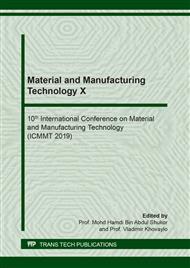[1]
Bose, S., et al., Microwave-processed nanocrystalline hydroxyapatite: Simultaneous enhancement of mechanical and biological properties. Acta Biomaterialia, 2010. 6(9): pp.3782-3790.
DOI: 10.1016/j.actbio.2010.03.016
Google Scholar
[2]
Hong, L., X. Hengchang, and K. De Groot, Tensile strength of the interface between hydroxyapatite and bone. Journal of biomedical materials research, 1992. 26(1): pp.7-18.
DOI: 10.1002/jbm.820260103
Google Scholar
[3]
Zhang, L., et al., Rapidly sintering of interconnected porous Ti-HA biocomposite with high strength and enhanced bioactivity. Materials Science and Engineering: C, 2016. 67: pp.104-114.
DOI: 10.1016/j.msec.2016.05.001
Google Scholar
[4]
Fang, Y., et al., Microwave sintering of hydroxyapatite ceramics. Journal of materials research, 1994. 9(1): pp.180-187.
Google Scholar
[5]
German, R.M., Powder metallurgy science. Metal Powder Industries Federation, 105 College Rd. E, Princeton, N. J. 08540, U. S. A, 1984. 279, (1984).
Google Scholar
[6]
Oghbaei, M. and O. Mirzaee, Microwave versus conventional sintering: A review of fundamentals, advantages and applications. Journal of alloys and compounds, 2010. 494(1-2): pp.175-189.
DOI: 10.1016/j.jallcom.2010.01.068
Google Scholar
[7]
Das, S., et al., Prospects of microwave processing: an overview. Bulletin of Materials Science, 2009. 32(1): pp.1-13.
Google Scholar
[8]
Gaustad, G., J.M.D.H. Shulman, and S. Allan. Susceptor investigation for microwave heating applications. in Innovative Processing and Synthesis of Ceramics, Glasses and Composites VIII: Proceedings of the 106th Annual Meeting of the American Ceramic Society, Indianapolis, Indiana, USA (2004). 2005. Wiley-American Ceramic Society.
DOI: 10.1002/9781118407820.ch3
Google Scholar
[9]
Harabi, A., N. Karboua, and S. Achour, Effect of Thickness and Orientation of Alumina Fibrous Thermal Insulation on Microwave Heating in a Modified Domestic 2.45 GHz Multi‐mode Cavity. International Journal of Applied Ceramic Technology, 2012. 9(1): pp.124-132.
DOI: 10.1111/j.1744-7402.2011.02632.x
Google Scholar


